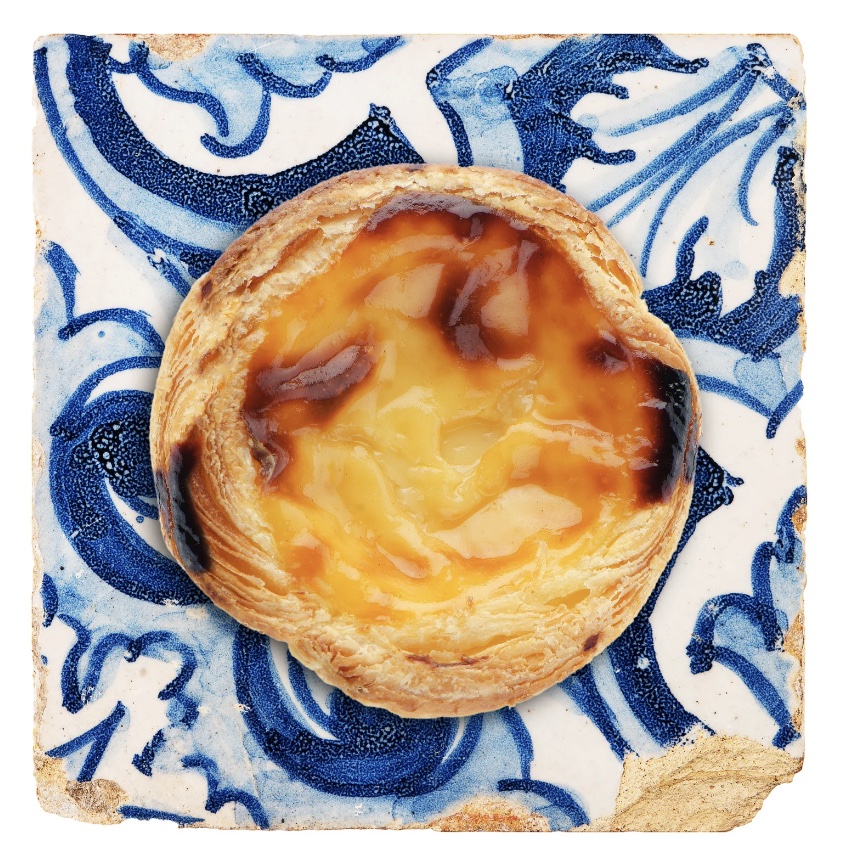GLUTEN FREE LISBON: A COMPREHENSIVE GUIDE OF PORTUGUESE FOOD FOR CELIACS AND GLUTEN-SENSITIVE TRAVELERS
Understanding gluten free needs in Lisbon
Even if deeply rooted in tradition, Portuguese cuisine often intertwines with the needs of celiac and gluten-sensitive travelers in surprising ways.

Guests during our free-gluten Original Food and Wine Experience!
When you are traveling around Lisbon, understanding the local context of gluten sensitivity is crucial for a safe and enjoyable experience. Portugal’s awareness of celiac disease and gluten intolerance is growing, in part thanks to the efforts of the Associação Portuguesa de Celíacos, the national celiac association, aka APC, in part also because of the consumer’s demands, including local folks as well as international visitors.
Even when you are a celiac, navigating Lisbon’s gastronomic wonders isn’t just about avoiding gluten. It’s about immersing oneself in the local culture with the confidence and knowledge to make informed choices. This guide, crafted by local Lisbon food experts, aims to empower gluten-free travelers with insights and tips to fully experience the culinary heart of Portugal, from traditional dishes to hidden gems, all while maintaining a gluten-free diet.
Gluten free food tours in Lisbon
Just because you have celiac disease or you’re simply following a diet void of gluten, that doesn’t mean you can’t explore the best of traditional Portuguese cuisine. The local food, while steeped in tradition, often leans towards naturally gluten-free ingredients and, whenever that is not the case, you can count on our carefully curated tours to present to you the most relevant of Portuguese dishes and ingredients, in a way that is safe.
We are proud to be a reference when it comes to gluten free food tours, and that we are often mentioned in Facebook groups such as Celiac Travel, as we do believe having travelers come to us because of word of mouth from previous guests is always the biggest compliment. Generally speaking, when you are in our country, we would want you to focus on the overall experience, absorb every bit of our culture as you can, and worry as little as possible about how your food has been cooked or what’s really in it.

‘Leite creme’, Portugal’s answer to crème brûlée
Whenever you mention this at the time of your booking, Oh! My Cod’s food and cultural tours can cater specifically to gluten-free requirements. We understand the nuances of gluten intolerance and celiac disease, ensuring that our offerings are suitable even for those with the most sensitive conditions, namely when avoiding cross-contamination is a must. As we explore below, Portuguese cuisine has numerous naturally gluten-free dishes. However, as we will see, there are misleading dishes which may look at a first glance like they do not contain gluten, when indeed they do. One such example would include some versions of leite creme, Portugal’s answer to crème brûlée, which is often thickened using wheat flour but it can be prepared only with egg yolks for textural reasons, as that is the case during our food experiences, thus making this creamy dessert safe for celiacs.
Overall, at Oh! My Cod we strive to understand the different levels of gluten insensitivity of our guests, as we know every individual is different. For instance, we love for you to taste the best cornbread (broa) which is artisanally made as very few of them still are around the city, and while it contains a residual amount of wheat only sprinkled on top, it may be suitable for those with relatively low gluten sensitivity, but certainly not a good option for celiacs, who will be served with an alternative option during our food tours. In any case, we will always explain what’s in the food we serve and give you the option to try it or not and, of course, provide replacements for those tastings and dishes we know you won’t be able to enjoy by default.
When you book to share a cultural experience with us, please let us know about your relationship with gluten, and we will take care of everything. Our tours ensure that you enjoy authentic Portuguese flavors without the worry.
The best gluten free dishes of traditional Portuguese cuisine
Portuguese cuisine, with its rich history and diverse regional flavors, offers a variety of naturally gluten free dishes that are integral to the country’s food culture. For instance, the repertoire of typical Portuguese dishes include many rice based recipes, in what is one of Europe’s largest producers and consumers of this grain, specifically of Carolino, a variety autochthonous to our country.
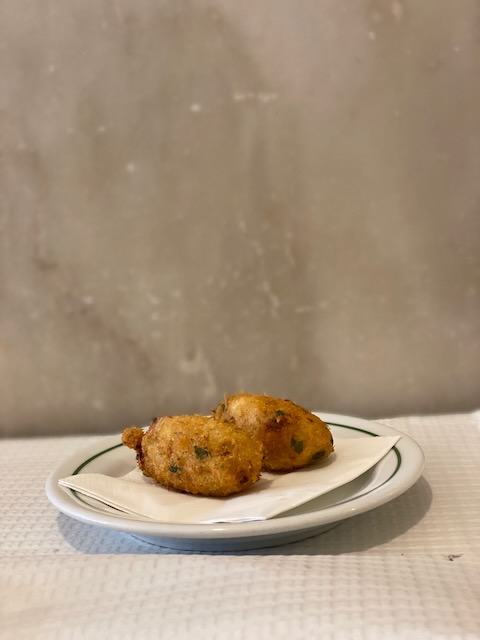
Salted cod cakes, fried just before served at Imperal de Campo de Ourique restaurant
For those seeking gluten-free options, the dishes we explore below not only provide safe options for celiacs and gluten-sensitive individuals but also offer a genuine taste of Portugal’s culinary heritage.
Gluten free Portuguese soups and appetizers
Couvert
When you sit down at a typical Portuguese establishment, you will often be presented with what we refer to as couvert. This is basically something to nibble on while you wait for your main meal to be served and, very often, even to start satiating you while you browse the menu. Kindly note that couvert is not complimentary but charged, based only on the items you end up consuming. Couvert is commonly composed of a bread basket, which you should definitely skip if you are avoiding gluten. But you can still munch on the other elements, which often include marinated olives, cheese and cold cuts, known in Portuguese in enchidos. Very often, fritters such as croquetes or rissóis (meat or shrimp turnovers) will also be featured, but these should be avoided as they will certainly contain flour or breadcrumbs. If you’d like to embrace the local fried goodness, ask for a pastel de bacalhau instead, as these salt cod cakes are usually prepared with the cured shredded fish with mashed potatoes, onions and herbs, and would by default be free of wheat.
Caldo verde and other soups
A comforting staple, caldo verde is a simple yet flavorful soup made with thinly sliced couve galega (collard greens), potatoes, onion, and garlic. Chouriço (Portuguese sausage) is often added for extra flavor, if not during the cooking process, at least at the time of plating as a topping. This dish is typically gluten-free and so are the vast majority of soups (vegetable or otherwise) which you will always be able to find in Portuguese eateries, from simple pastelarias to more elegant restaurants. Once common soup to be a little more wary of would be canja, that is chicken soup, which may include tiny pasta, but is also often prepared with rice. Simply make sure to ask before you place your order, and you can even take this as an opportunity to practice your Portuguese, by saying “a canja foi feita com massinhas ou arroz?”, which translates as “was the chicken soup made with pasta or rice”?
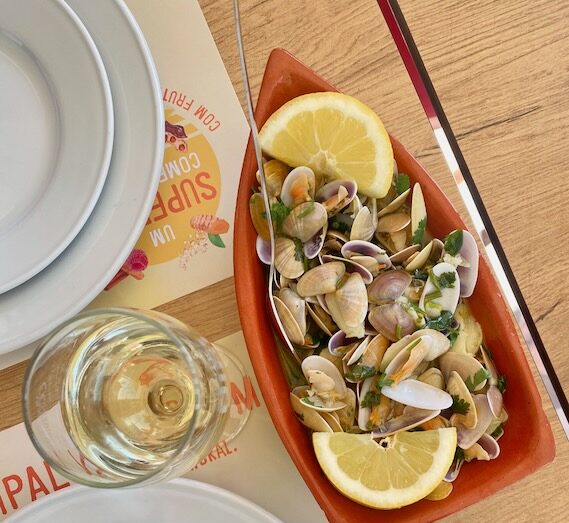
‘Lamejinhas’ are another kind of bivalve that can also be cooked Bulhão Pato style; these were ordered at Fonte da Telha beach!
Ameijoas à Bulhão Pato | clams in Bulhão Pato sauce
This popular appetizer consists of clams cooked in a sublime broth of garlic, olive oil, and coriander, with a splash of white wine and/or lemon juice. It’s a classic Portuguese dish, usually safe for gluten-free diets, which brings together the briny quality of the shellfish with the tang of the wine or lemon, resulting in a very refreshing experience. As the clams are swimming in broth, the server will often try to convince you to order a side of buttered toast. Make sure you explain you are following a gluten-free diet, and simply skip the bread and ask for gluten free bread (‘Tem pão sem gluten, por favor?’), which in some establishments may indeed be available now-a-days, even in surprisingly traditional eateries which keep an open mind. Pro tip: use the actual shells of the clams to scoop up the sauce because, one thing is for sure, you will not want to leave that flavorful broth behind!
Salada de polvo | octopus salad
Conventionally, most seafood based Portuguese appetizers are gluten free. That is the case of the clams recipe above, and the same goes for octopus salad, a classic appetizer in many seafood focused restaurants. To make this salad the octopus is first cooked until tender, which is a crucial step. This process usually involves boiling the octopus with some aromatic herbs and perhaps a bit of onion and garlic, to infuse it with flavor. The key is to achieve a texture that is tender and succulent, not rubbery, which is the hallmark of well-prepared octopus. Once cooked, the octopus is cut into bite-sized pieces and it is then mixed with a variety of fresh ingredients, including finely chopped onions, sweet bell peppers, and parsley. A tangy marinade with olive oil and vinegar brings everything together, complementing the octopus but without masking its natural taste.
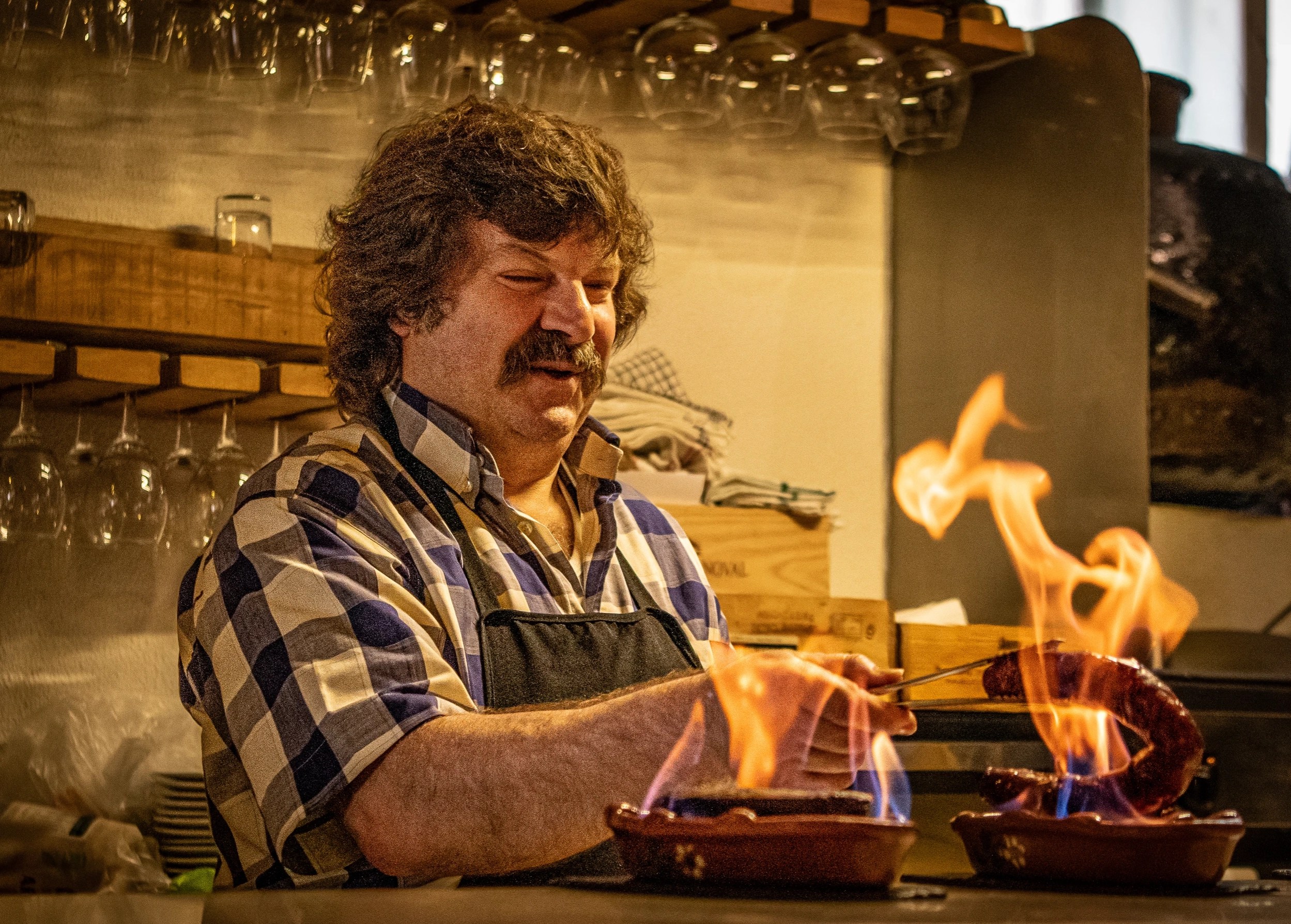
Lovely Armando, during our Original Food and Wine tour (© Diane Gordon)
Chouriço assado | fire roasted chorizo
Known for its rich, smoky flavor and a hint of spice derived from paprika, chouriço is a type of Portuguese sausage best enjoyed roasted. The uniqueness of chouriço assado lies in its method of cooking. The sausage is placed in a special clay dish which is designed to hold the chouriço over a small flame, usually provided by burning alcohol in the bottom of the dish. The process of cooking the chouriço over an open flame not only intensifies its flavors but also adds a delightful smoky aroma. As it cooks, the surface of the sausage becomes slightly charred, enhancing its texture and taste. To serve, the chouriço is often sliced into thin pieces, making it easy to share and enjoy as an appetizer.
Gluten free Portuguese dishes: fish and meat recipes which are naturally gluten free
Sardinhas assadas and other fish grills
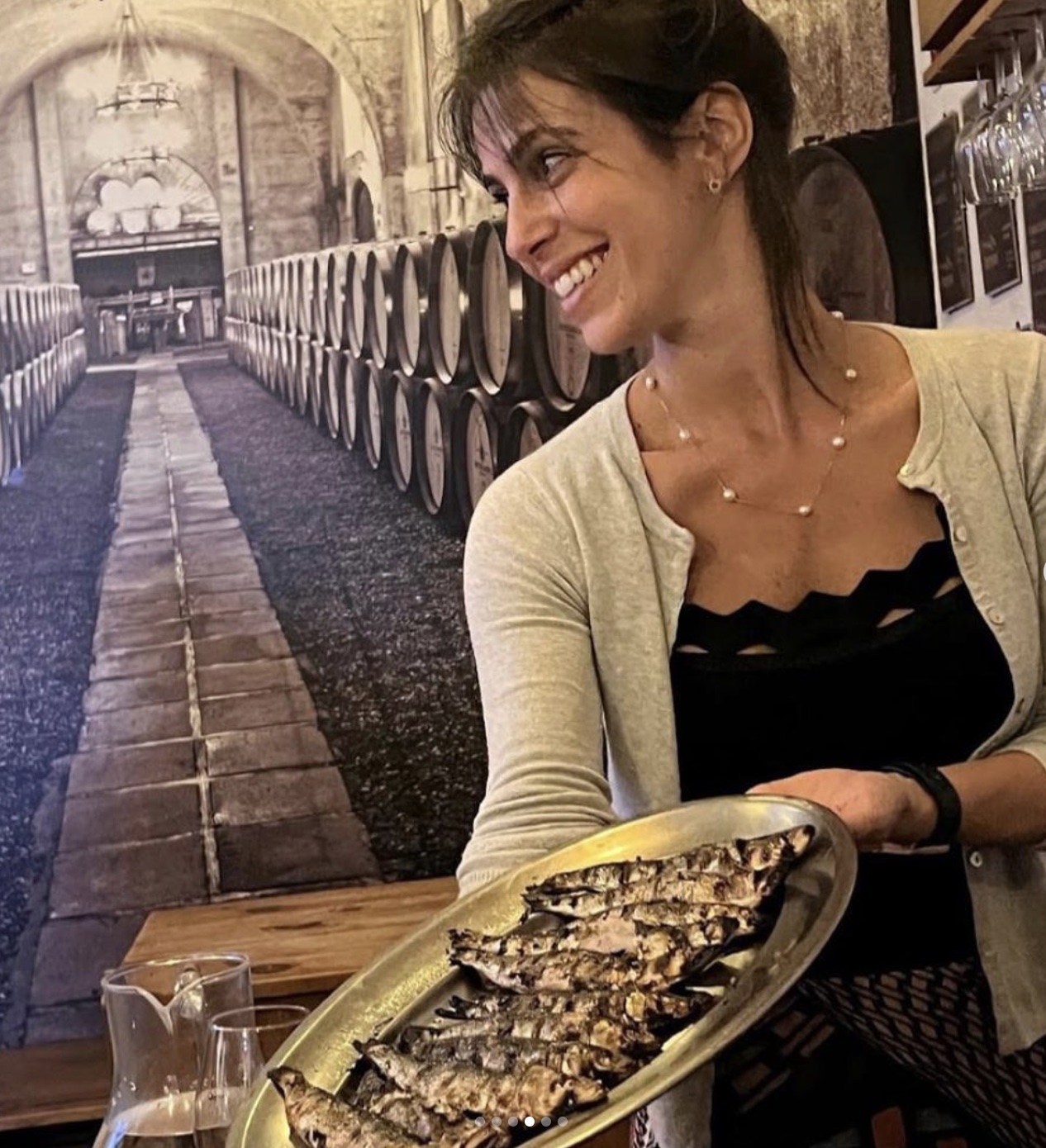
The amazing food host Livia and some sardines, during our food and cultural tour
A summer favorite, especially during the festival of Santo António, fresh sardines grilled to perfection are one of Lisbon’s favorite foods. And, luckily, one that gluten free travelers will not have to miss out on. Sardines, just like most grilled fish dishes which abound all over Portugal which follows the so-called Atlantic diet, particularly in coastal areas such as Lisbon and around it, are usually served with boiled potatoes and steamed vegetables, making them safe for gluten free travelers. When we’re talking about fried fish, the staple side of choice is usually rice but if fried fish is on the menu, you ought to double check about the way of making it, as very often a wheat based batter would be involved in the recipe. Once again, don’t be shy and try saying in Portuguese “o peixe foi panado ou passado em farinha antes de fritar?”, that is, “does the fish involve some sort of breadcrumbs or batter prior to frying?”.
Other fish and seafood specialities in Portugal which you can safely enjoy while on a gluten free diet would include lulas (squid) and chocos (cuttlefish), as long as these are grilled and not fried. Espetadas (see more below), typical skewers usually featuring seafood, or a mix of seafood and meats, could also be a delicious option!
Bacalhau: which Portuguese salt cod recipes are gluten free?
Salt cod, or bacalhau in Portuguese, is a cornerstone ingredient in Portuguese cuisine and is used in a multitude of dishes. While many salt cod dishes are naturally gluten-free, some traditional recipes do incorporate gluten-containing ingredients. Here’s are some typical bacalhau dishes, suitable for those following a gluten-free diet:
Bacalhau com todos: This dish features boiled cod served with a variety of boiled sides like chickpeas, potatoes, and vegetables. It’s a straightforward and naturally gluten-free dish.
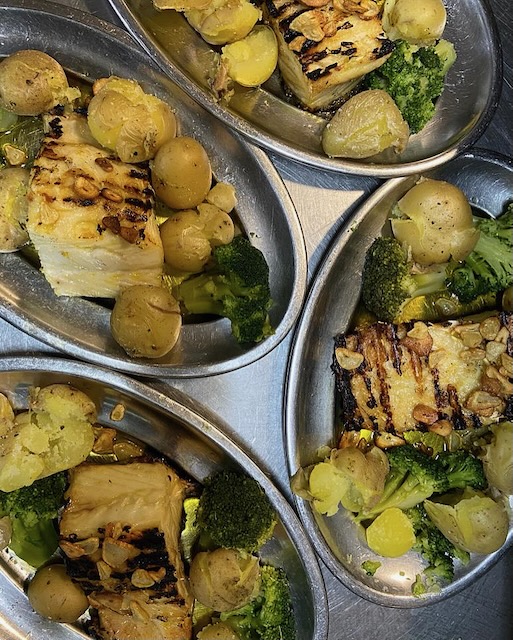
Salted cod ‘lagareiro’ style, during one of our food and cultural tours
Bacalhau à lagareiro: In this preparation, bacalhau is roasted with potatoes and flavored with garlic olive oil, offering a gluten-free option full of flavor.
Bacalhau à Brás: Although traditionally this dish involves shredded cod scrambled with fried matchstick potatoes and onions, it’s generally gluten-free unless flour is used in the preparation of potatoes. When in doubt, just ask, but the vast majority of the time it would be good to go!
Bacalhau à Zé do Pipo: This is a comforting dish where salt cod is covered with creamy mashed potatoes and topped with mayonnaise, then gratinated. It’s typically gluten-free, but it’s always good to check that no flour is used, for example, in the mashed potatoes.
Bacalhau à Gomes de Sá: A simple boiled cod casserole with potatoes, boiled eggs, and olives, this dish is naturally gluten-free and a staple in Portuguese cuisine.
Bacalhau‘s versatility allows it to be featured in a variety of dishes, ranging from simple, boiled preparations to more complex, gratinated ones. As recipe’s may vary according to the chef, for more complex dishes other than rices and grills, we suggest you always ask about the ingredients involved – the small Portuguese gluten free translation card you’ll find at the bottom of this article aims to make your life easier in this regard! In any case, these are the bacalhau dishes you should avoid in Portugal, and which will most likely contain gluten: bacalhau com broa (oven-roasted cod with a cornbread crust), bacalhau espiritual (gratin-style dish with cod, vegetables, and bechamel sauce), bacalhau à Minhota (fried cod, which may include coating the fish with flour prior to cooking). If you are curious to try bacalhau com natas, oven baked cod with cream, ask before ordering, as most recipes will indeed call for cream but it’s not unheard of for some cooks to use bechamel sauce instead, which is thickened with flour. “O bacalhau com natas foi cozinhado com natas ou com molho bechamel?”, that is, “was the bacalhau com natas cooked with actual cream or bechamel sauce?”, might help you clear this up if your server doesn’t speak good English, or simply if you’re brave enough to navigate Lisbon’s food scene in the local language!

Homemade, salted cod ‘caldeirada’: another zero gluten Portuguese dish
Polvo à lagareiro | octopus lagareiro style
The star of this dish is the octopus, known for its potential to be divinely tender when cooked correctly. The process begins with boiling the octopus, which is then typically roasted or grilled, which imparts a slightly charred, smoky flavor that contrasts beautifully with the natural sweetness of the meat. What truly sets polvo à lagareiro apart is the use of lagareiro style, a term traditionally associated with olive oil producers (lagareiros). In this method, the cooked octopus is lavishly drizzled with high-quality Portuguese olive oil, often infused with garlic. This generous use of olive oil not only adds a rich, velvety texture but also enhances the flavors of the octopus. Accompaniments for this dish are simple, yet they play a crucial role. Polvo à Lagareiro (similar to bacalhau à Lagareiro, mentioned above) is often served with batatas a murro – small, boiled potatoes that are lightly crushed and then roasted until they have a crispy exterior. These potatoes absorb the flavors of the olive oil and garlic, making them a perfect complement to the tender octopus, in a naturally gluten free marvel.
Arroz de marisco and other seafood based Portuguese rice dishes
Reflecting the country’s long-standing relationship with the sea, this dish is celebrated for its rich flavors and comforting texture, making it a favorite among both locals and tourists, including gluten free travelers. At its core, arroz de marisco is a hearty, risotto-like dish, but with a distinctly Portuguese twist. It is made with a variety of fresh seafood, which can include clams, shrimp, mussels, crabs, and sometimes squid, octopus or even lobster. The selection of seafood often depends on the region and what’s available locally, offering a taste of the local maritime bounty. The seafood is cooked in a savory broth, which is flavored with onions, garlic, tomatoes, and a touch of white wine. Rice is the staple ingredient that ties everything together. It absorbs the flavors of the broth and seafood, resulting in a creamy and luscious texture. The rice used is typically a short-grain variety, similar to what is used in risotto, which is key to achieving the desired consistency.
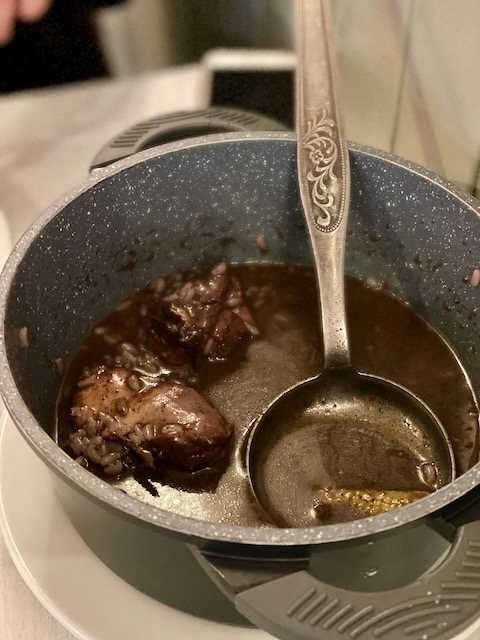
‘Cabidela’ rice served at Belmiro restaurant, a place we absolutely love!
Other seafood rice dishes worth looking out for in Portugal include: arroz de polvo (octopus rice), arroz de tamboril (monkfish rice), arroz de lampreia (lamprey rice), arroz de lingueirão (razor clam rice), arroz de bacalhau (salt cod rice), to name just a few.
If the flavors of the ocean sound particularly appealing to you, we also recommend tasting caldeirada (a hearty stew with different pieces of fish, cooked with potatoes in a tomato and onions enriched broth), feijoada de choco (white bean stew with cuttlefish strips) and cataplana (steamed seafood, or a combination of seafood, fish and meat, steamed inside a clamshell looking cooking ware which also goes by the name cataplana, served everyday in Lisbon, for example, at Maria Catita Restaurant – Rua dos Bacalhoeiros 30).
Arroz de cabidela | braised chicken rice with blood
Arroz de cabidela, often simply referred to as cabidela, is a traditional Portuguese dish known for its unique preparation and bold flavors. This is a comfort dish you’ll come across in local eateries mostly during winter months, so it’s considered a seasonal specialty. The key ingredient in cabidela is slowly cooked chicken until tender in a mixture of its own blood, vinegar, and a variety of aromatic spices and herbs. This might sound unusual to those unfamiliar with the dish, but it’s a practice seen in various cultures around the world and imparts a distinctive, rich flavor and color to the dish. Rice is then added to the pot, where it absorbs the cooking liquid, resulting in a creamy, risotto-like texture. The rice takes on the deep, earthy flavors of the meat and its marinade, creating a hearty and satisfying meal which happens to be ideal for gluten-sensitive individuals or celiacs craving an age-old Portuguese recipe which continues to be cherished in modern times.
Carne de porco à Alentejana | pork and clams Alentejo style
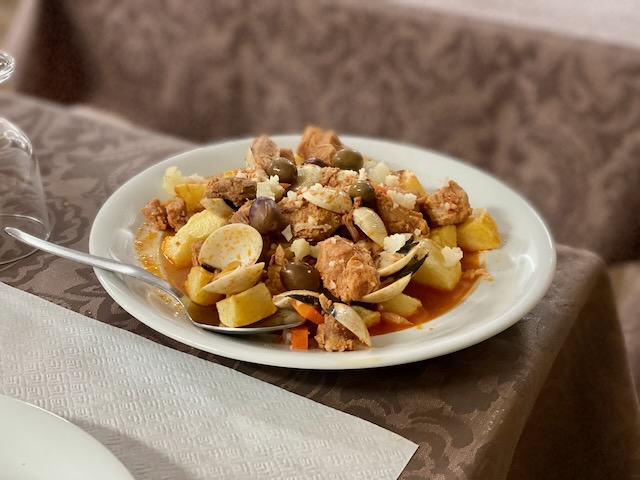
Another Portuguese dish free gluten: pig Alentejano style. This one at a family owned restaurant in the North of the Alentejo region
This is a quintessential regional dish from the Alentejo, that showcases the harmonious blend of land and sea, as it features a unique combination of pork marinated in wine and garlic, cooked with clams. One of the unique aspects of carne de porco à Alentejana is the textural contrast between the tender pork and the slightly chewy clams. This interplay of textures, coupled with the robust flavors, makes the dish both interesting and satisfying. Traditionally, the dish is served with cubed fried potatoes, which absorb the flavorful sauce, and often with a sprinkle of fresh cilantro on top for an added burst of freshness. For those with gluten sensitivities, carne de porco à Alentejana is typically a safe choice.
If you are a meat lover, we also recommend trying other meat dishes which are normally gluten free as they consist of a classic meat and potato combination. Such dishes include, but are certainly not limited to: leitão assado (spit-roasted suckling pig, served with fried chips), borrego (lamb), cabrito (goatling), coelho (rabbit) and other pork dishes such as carne de porco à Portuguesa (similar to carne de porco à Alentejana, but replacing the clams for pickled veggies) and rojões (Minho style fried chunks of pork, with potatoes and/or chestnuts).
Arroz de pato | oven-baked duck rice
Yet another rice based dish safe for gluten free folks, duck rice is prepared by simmering duck with aromatic herbs, onions, and garlic, creating a rich and flavorful broth. Once the duck is cooked, its meat is shredded and set aside, while the broth from cooking the duck is then used to cook the rice. The shredded duck is mixed with the rice, and the dish is often garnished with slices of chorizo, which add some smoky depth of flavor, before being baked in the oven until a crunchy top layer is created. Such a comforting meal!
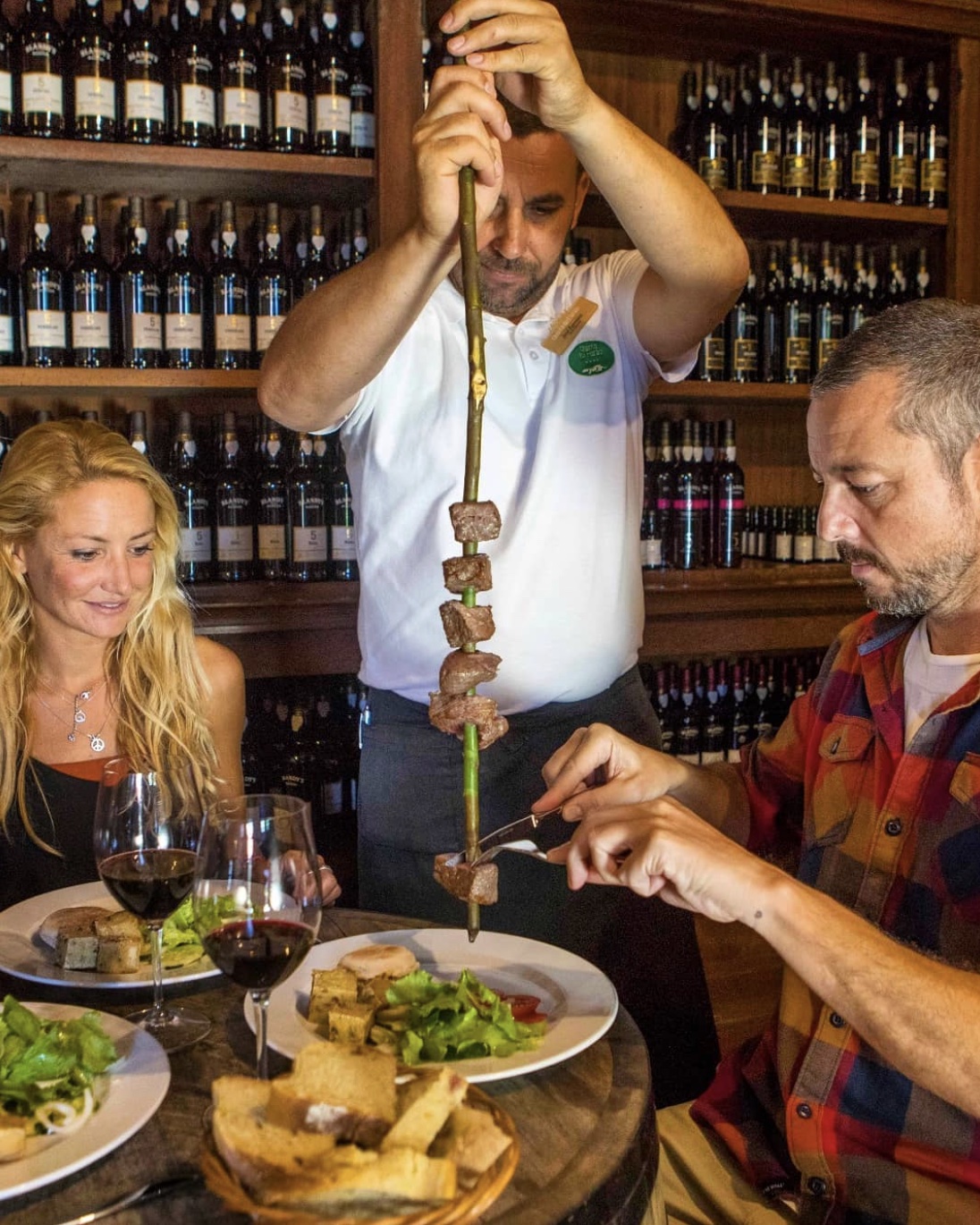
‘Espetada da Madeira’ © visitmadeira.com
Frango de churrasco | peri-peri chicken
This is a beloved Portuguese grilled chicken dish, famous inside the country as well as worldwide, in great part thanks to international chain Nando’s. This dish is typically gluten-free, as the marinade and peri-peri sauce that the charcoal grilled chicken is slathered with are made from naturally gluten-free ingredients, and the most common side dishes to be served with frango de churrasco are batatas fritas (fries or chips), arroz branco (steamed white rice) and salada mista (a straightforward salad of lettuce, tomato and white onions). Peri-peri chicken offers gluten-free travelers an authentic taste of Portuguese grilling and BBQ culture.
Espetadas and other meat grills
Originating from Madeira, espetadas are skewers of marinated meat, seafood, or a combination of both. While in Madeira they are frequently served with milho frito, a gluten-free fried cornmeal dish akin to polenta, On the Portuguese mainland, espetadas are more commonly accompanied by boiled potatoes, vegetables, or salad, maintaining their gluten-free status (in Lisbon, try O Madeirense, in Amoreiras Shopping Center).
If you are into grilled meats, keep an eye out for grelhada mista, which basically consists of a platter with mixed grill, which may feature a combination of beef, chicken and different cuts of pork, including cured sausages, more often than not served with potato fries and perhaps a simple side salad. If ribs are your jam, look out for piano or entrecosto. Last but not least, if you’re into bold meaty flavors, we can’t help but recommend grills with porco preto, that is, Iberian black pork.
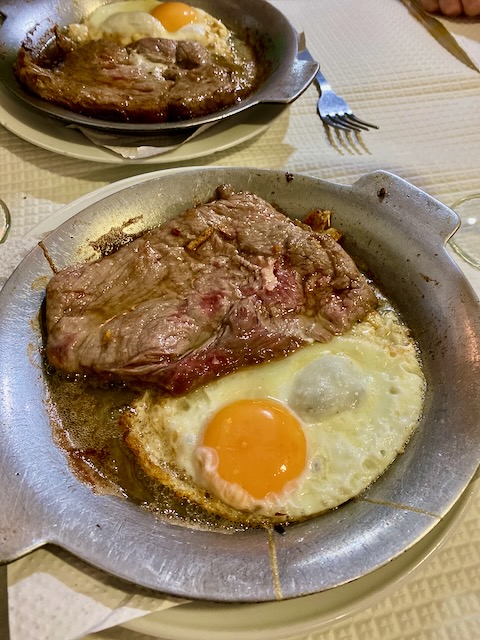
My favorite ‘bitoque’ in Lisbon, remains a secret!
Bitoque | beef steak with a fried egg
Bitoque is often regarded as a go-to meal for many locals. Its widespread popularity is mirrored in its ubiquitous presence in eateries across the country, often offered at a reasonable price, making it both a comfort food and a culinary staple. The dish comprises a simple yet satisfying combination: a grilled beef steak that’s usually seasoned lightly to enhance its natural flavors, typically served with a fried egg on top, homemade fries, along with a salad, often consisting of lettuce, tomato, and onion, dressed lightly with olive oil and vinegar. One of the key aspects of bitoque is its sauce, which is subtly flavored and typically made with a combination of the steak’s juices, garlic, and white wine. Bitoque‘s appeal lies in its simplicity and the comfort it offers, to anyone hungry, gluten free or not.
Best Portuguese desserts for celiacs
If you are a celiac or adhering to a gluten-free diet, you’d probably be very glad to read that Portuguese cuisine offers a range of delightful desserts that can be safely enjoyed. Many traditional Portuguese desserts are naturally gluten-free – these are some of them:
Conventual desserts
Portuguese conventual desserts, aka doces conventuais, known for their historical roots in convents and monasteries, are a unique aspect of the country’s culinary heritage. These desserts are traditionally rich in eggs, sugar, and often nuts as well. However, the suitability of these sweets for a gluten-free diet varies greatly depending on the specific recipe. Examples of conventual desserts which are naturally gluten-free, include:
Pudim flan: Similar to crème caramel, this smooth, creamy dessert is made with caramelized sugar and has a rich custard base. It’s a popular choice for a sweet ending to a meal.

Chef Miguel Oliveira version of Abade Priscos pudding
Pudim Abade de Priscos: A unique Portuguese pudding made primarily with eggs, sugar, and a small amount of bacon, giving it a distinctive flavor.
Ovos moles: A specialty from Aveiro, made from egg yolks and sugar, often encased in a thin wafer made from rice flour, which is gluten-free.
Fios de ovos: Literally translating to ‘egg threads,’ this is a delicate and sweet dessert made from egg yolks drawn into thin strands and boiled in sugar syrup. It’s often used as a garnish for other desserts but can be enjoyed on its own.
Dom Rodrigos: Originating from the Algarve region, these are egg yolk threads combined with sugar and almond, wrapped in colorful foil. They typically do not contain gluten.
Arroz doce | sweet rice pudding
A classic dessert, this creamy sweet rice pudding consists of rice cooked in milk, flavored with lemon zest and cinnamon, and finished off with egg yolks for a richer consistency. It’s a comforting and simple treat, often found in traditional Portuguese restaurants and served in festivities such as popular festivals like the St. Anthony parties in Lisbon during June. The simplicity of these ingredients is key to its gluten-free nature.
Molotov | egg whites flan
Also known as pudim molotov, this is another excellent example of a traditional Portuguese dessert that is inherently gluten-free. It is an airy dessert made from egg whites and sugar, often served with caramel or creamy egg jam (doce de ovos). Its unique texture and subtle sweetness offers a delightful contrast to the often rich and dense nature of other Portuguese sweets, thus making molotov a cherished choice by many regardless of dietary restrictions.

Maçã assada & peras bêbedas | baked apples and pears cooked in red wine
This is quite an unpretentious yet delicious dessert, where apples are baked and often spiced with cinnamon, providing a naturally gluten-free and fairly healthy option, at least when compared to other sugar and fat loaded desserts. Portuguese style maçã assada is usually prepared with Reineta, a type of apple known for its starchy nature which works quite well texture wise once it has spent some time in the oven. If you like pears, try peras bêbedas, which are poached pears, typically cooked in red wine and spices, and offer a rich and flavorful dessert experience.
Baba de camelo | condensed milk mousse
A popular dessert with a whimsical name translating to camel’s drool, this is a velvety mousse made from cooked condensed milk. This dessert is particularly suitable for celiacs and those on a gluten-free diet, as its traditional preparation is inherently free from any gluten-containing ingredients. It consists of roughly two ingredients: cooked condensed milk and eggs, at the most topped with some shaved nuts. Minimalism never tasted this good!
Mousse de chocolate | chocolate mousse
A classic chocolate mousse is a frequent find in Portuguese eateries and is typically gluten-free, consisting of rich chocolate melted together with copious amounts of butter, sugar and fluffed up eggs. It may not be the most traditional of Portuguese recipes when compared to other old-time desserts, such as most of the conventual sweets, but there’s no doubt that a good mousse de chocolate is as stereotypical as it comes in Portuguese eateries.
Portuguese dishes which seem gluten free but are not
Even though Portuguese cuisine is rich in gluten-free options, including various fish dishes, meats, and vegetables, the nuances of Portuguese cooking methods and local ingredients can sometimes pose a risk for cross-contamination.
Some of the most common Portuguese foods which may seem to be gluten free but are generally not, include:
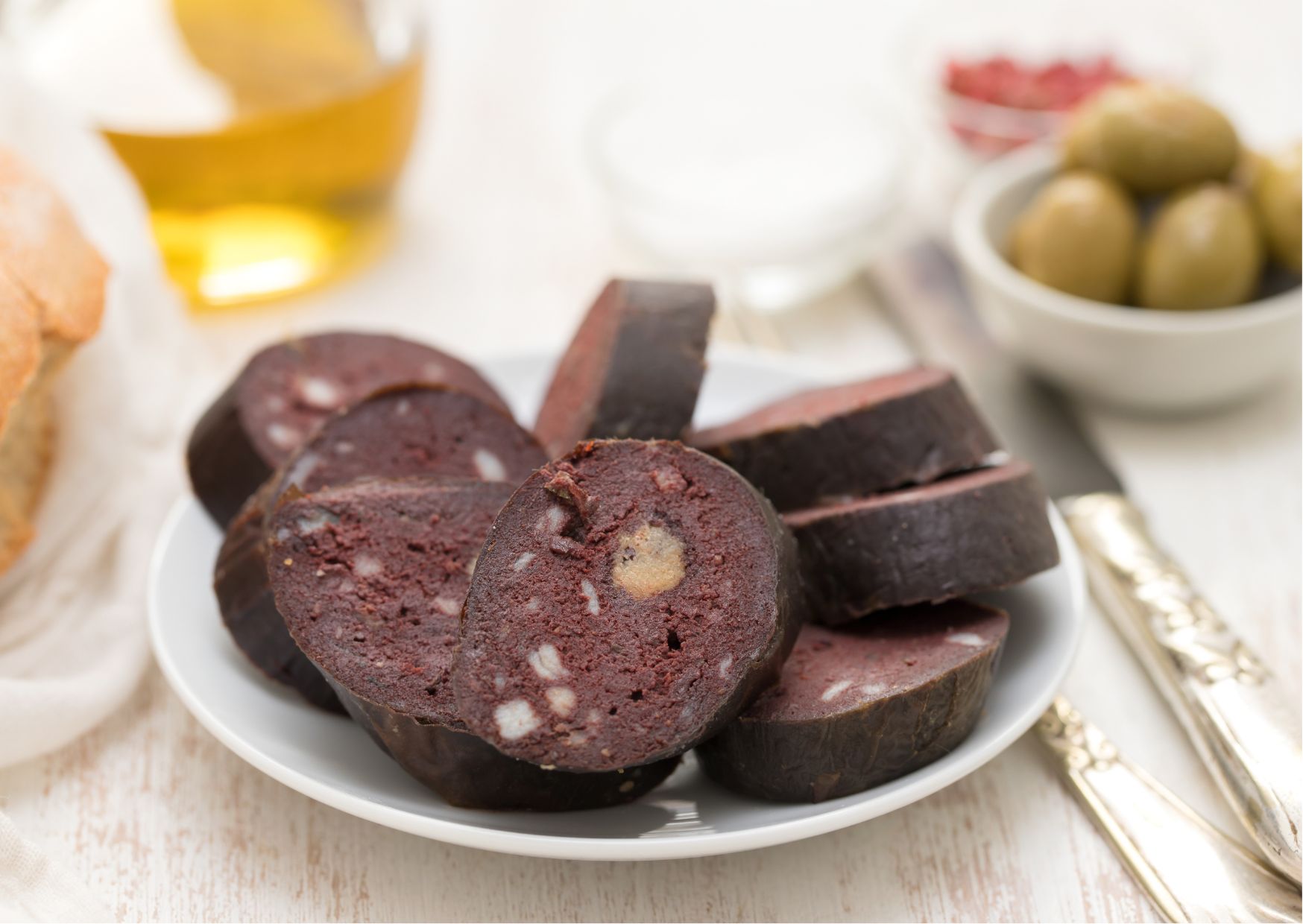
Portuguese ‘Morcela’
Broa | portuguese cornbread
Commonly referred to as Portuguese cornbread, broa might seem like a gluten-free option at first glance due to its primary ingredient being cornmeal. However, traditional recipes for broa often include wheat flour or rye flour along with the cornmeal, primarily for texture and binding purposes, so broa would generally not be a safe option unless specifically stated to be gluten-free or, like the broa we present to our guests during our Portuguese Cuisine: 17 tastings food tour, made 99% of actual corn, which makes it an actual option for people with low gluten sensitivity.
Alheira and farinheira | sausages with bread
Alheira and farinheira are two types of Portuguese sausages that may initially seem to be gluten-free due to their main ingredients being meats and fats. The reason why these sausages are not gluten-free lies in their traditional recipes. Originally created by the Jews during the Inquisition as a way to avoid persecution by simulating the consumption of pork, alheira is made with a variety of meats, like poultry and game, mixed with bread for binding. The inclusion of bread, which contains wheat and therefore gluten, is a key component of the sausage, giving it the right texture and consistency. Similarly, farinheira is traditionally made with pork fat, spices, and flour, with the latter ingredient being the source of gluten. The flour (usually wheat flour) is used to bind the ingredients together and to give the sausage its characteristic texture.
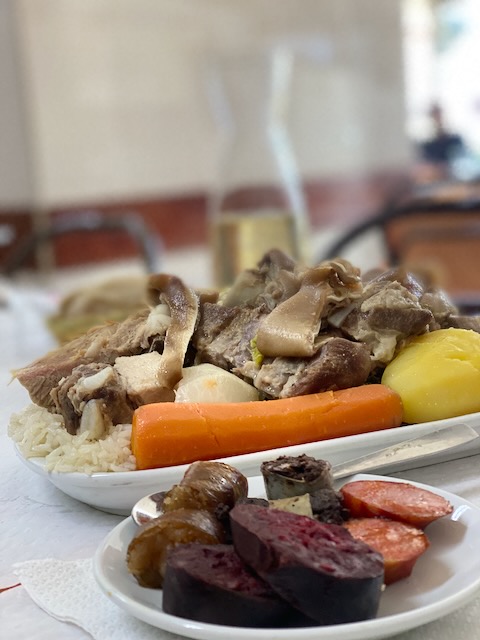
For those who tolerate cross contamination, you can even eat ‘cozido à Portuguesa’. Just avoid the ‘morcela’ and the ‘farinheira’ sausages!
Morcelas | Portuguese blood sausages
Understanding the different varieties of Portuguese blood sausage varieties is crucial for those avoiding gluten. Traditional Portuguese morcela is made from pork blood, pork fat, and a variety of seasonings, which often include onions, garlic, and spices. The key ingredient that introduces gluten into this variant is flour, usually wheat flour, used as a binding agent and to give the sausage its characteristic dense texture. Therefore, despite its meaty ingredients, regular morcela is not a gluten-free option. On the other hand, we have morcela de arroz, that is, blood sausage prepared with rice instead of flour. The rice not only acts as a filler and binding agent but also imparts a unique texture and slightly different flavor profile to the sausage. This adaptation makes morcela de arroz an excellent choice for those who wish to enjoy traditional Portuguese bloody flavors without gluten. If you are extremely sensitive to gluten though, note that cross-contamination could still be a concern, as these morcelas would typically be prepared in the same facilities.
Typical stews known as ensopados
Ensopados in Portuguese cuisine refers to a style of stew served over slices of bread. While this may not look obvious as the meats and juices hide the bread on the bottom of the serving platter, this is clearly not a suitable option for celiacs. However, if you are interested in the meat, you could always ask for the actual stew to be served on its own, or perhaps with some rice, instead of the customary way of presenting it over bread.
Bolo de arroz | Portuguese rice muffin
Despite its name, which literally translates to rice cake, this popular Portuguese pastry is made with wheat flour and not just rice flour, thus containing gluten.
Leite creme | Portuguese crème brûlée
This Portuguese version of crème brûlée is a delightful custard dessert, usually topped with a thin layer of caramelized sugar, adding a satisfying crunch to the creamy base. We consider that a bonafide leite creme would only be thickened by a generous amount of egg yolks (like those we serve on our food tour, but realistically we know that a lot of cooks do use flour instead, or at least a combination of it plus the eggs. The same technique applies to the custard found inside a pastel de nata, which would not in any case be a gluten free cake, as it includes puff pastry.
To be 100% sure, always ask your server about what’s in your meal and how it has been cooked. For easier communication, refer to the useful Portuguese words for gluten-free travelers we focus on below.
Best gluten free restaurants in Lisbon
As we have explored above, there are a myriad of typical Portuguese dishes which are naturally gluten free and which you can come by any given local restaurant, both in Lisbon and in most parts of the country. Yet we understand that, sometimes, you may just want to lay back and relax and be able to order anything from the menu. For those occasions, we are happy to present you with some of the greatest restaurants in Lisbon with a fully gluten-free menu:
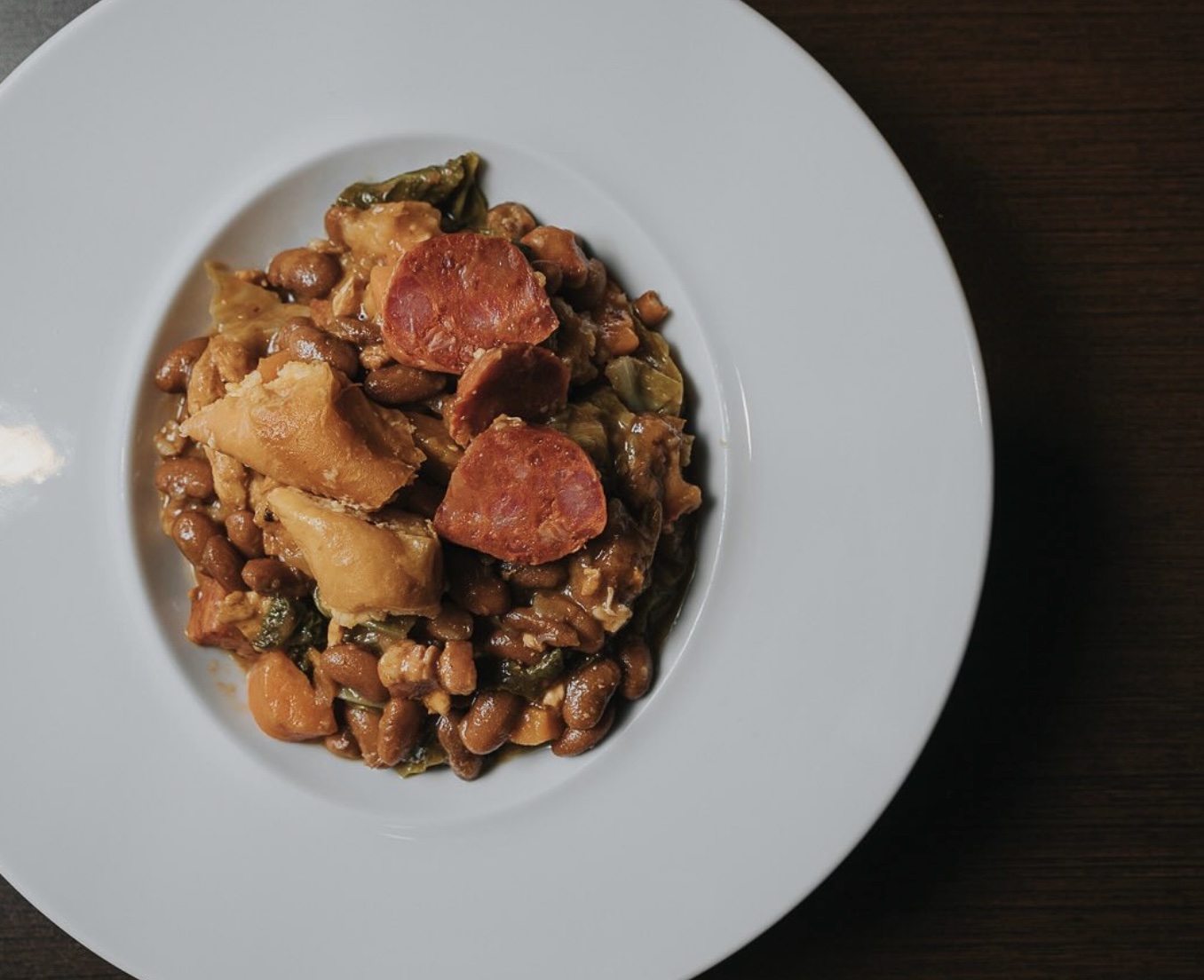
© Rice Me
Rice ME
Born from a passion for the versatile grain rice, Rice ME offers a diverse menu ranging from grain-based dishes to pastas, all catering to gluten-free and lactose-free diets. Emphasizing natural ingredients, their dishes are 100% natural and certified by the Associação Portuguesa de Celíacos, ensuring safety and quality. They also have a deli section, Rice ME Deli, which focuses on quick, healthy meals and snacks, maintaining the same commitment to being 100% gluten-free. Rice ME even offers gluten-free versions of classic cocktails using rice-based ingredients like sake, alongside family meal trays and gluten-free cakes for special occasions.
📍Rua Carlos Testa 18A, 1050-046 Lisbon
The Food For Real
The menu at The Food for Real is designed to be inclusive, offering a variety of gluten-free options that do not compromise on taste or creativity. In addition to their gluten-free offerings, this gluten free cafe is also conscious of other dietary needs and preferences, including vegan and vegetarian options. This makes it a versatile choice for diners with various dietary restrictions or preferences.
📍Rua dos Lusíadas 51 A, 1300-366 Lisbon
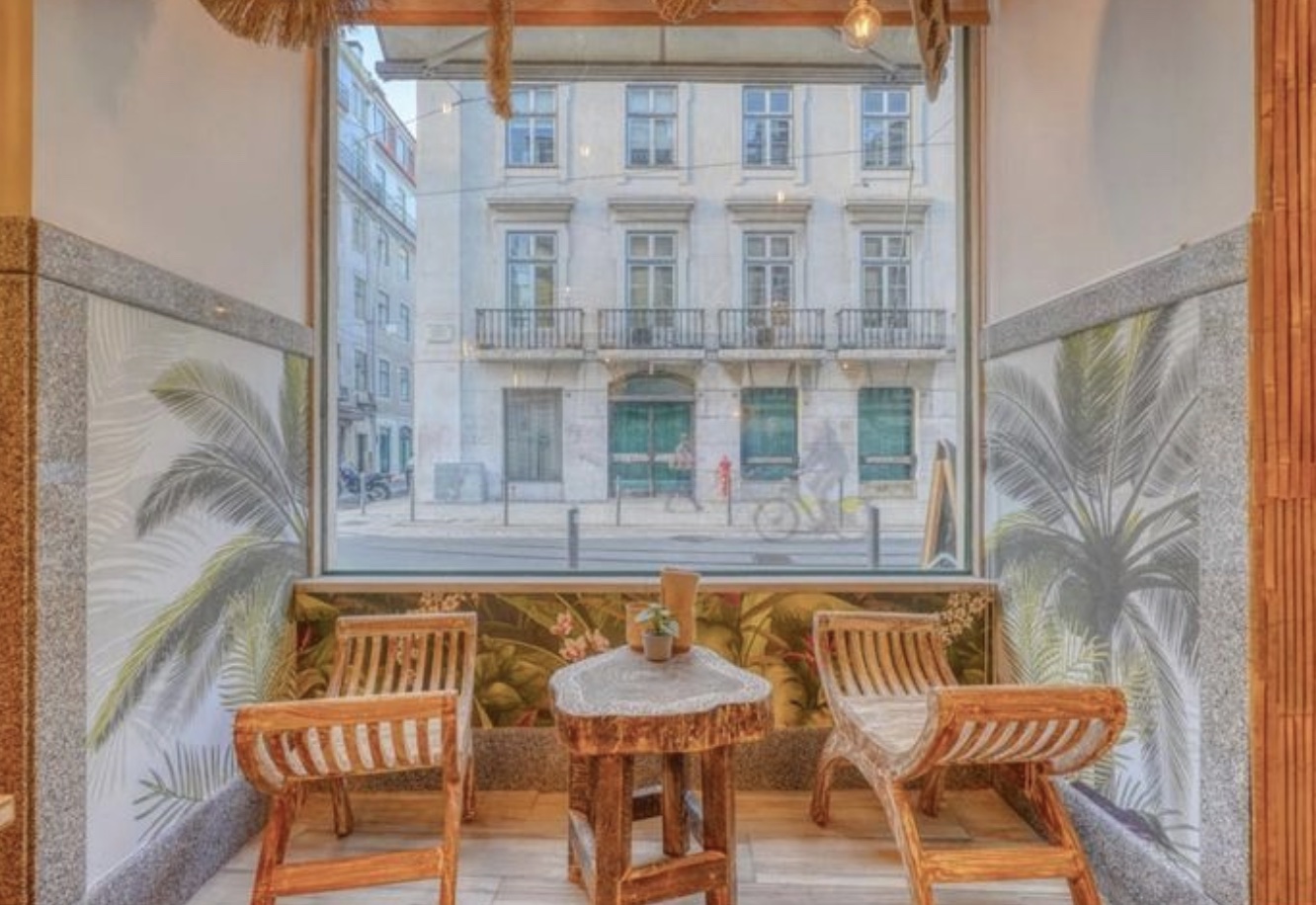
© Bali do Cais
Bali do Cais
Famous for its certified gluten-free offerings, Bali do Cais is a gluten free bakery and restaurant formerly known as Zarzuela, now hybridized with an Indonesian food concept. Not only do they provide gluten-free versions of the beloved pastel de nata, but their menu also includes a variety of main meal options with some of the most distinct flavors from Bali and Indonesia as a whole. The commitment to avoiding cross-contamination makes this place a safe choice for those with severe gluten sensitivities.
📍Rua Bernardino Costa 21 1200-052 Lisbon
https://balidocais.pt/index.html
Despensa N.6
This is a Lisbon-based healthy, paleo, gluten-free pastry shop (certified by the APC), with vegan and artisanal production. They are particularly renowned for their 100% gluten-free and sugar-free offerings. This bakery and café is a haven for those with celiac disease, gluten sensitivities, or anyone looking for healthier dessert options. They creatively use alternative ingredients like almond flour, coconut flour, and natural sweeteners to craft their baked items, ensuring that they are not only safe but also delicious. Despensa N.6 is a lovely spot where to relax while enjoying a gluten free breakfast in Lisbon.

© Sam Pastelaria Saudável
📍Av. Sacadura Cabral 6A, 1000-274 Lisbon
Sam Pastelaria Saudável
Sam is a health-focused gluten free bakery in Lisbon, specifically located in the neighborhood of Alvalade. Their products are certified gluten-free by the APC, making them a safe and ideal choice for celiacs and those following a gluten-free diet. In addition to being gluten-free, their offerings are also free from dairy and refined sugars. Sam Pastelaria Saudável provides a range of vegan options and sugar-free choices, ensuring that their products cater to a wide array of dietary preferences. With a commitment to health, they offer a variety of products including artisanal cakes, tarts, and sweet treats, all made with a focus on health and quality ingredients.
📍Rua Luís Augusto Palmeirim 1D, 1700-272 Lisbon
Special gluten free cravings in Lisbon

© Gino’s
Whether you are craving a pastel de nata, an indulgent slice of pizza or even a simple fluffy bread, we tell you the best local spots where you can satisfy your cravings with no gluten involved! These may not always be fully gluten free eateries as the ones we highlight above, but they do a wonderful job at serving gluten free options:
Gluten free vegan options
If besides being gluten free you are following a vegetarian or vegan diet, we’d recommend booking a table at Ao 26 Vegan Food Project (Rua Horta Seca 5). While primarily a vegan restaurant, they also offer a good variety of gluten-free options. Their menu is a testament to creative vegan cooking, and they are conscious about catering to gluten-free diets as well. Orteá (formerly known as O Botanista, at Rua Dom Luís I 19), which is owned by the same team as Ao26, although also not exclusively a gluten-free restaurant, serves many scrumptious gluten-free options, especially focusing on organic ingredients.
Gluten free bread in Lisbon
Long gone are the days when eating out following a gluten free diet in Lisbon meant skipping the bread basket. Today, you will find delicious and actually fluffy bread with no gluten whatsoever at several eateries, including some of the places we have already mentioned above (namely Bali do Cais, Ao 26 Vegan Food Project and Orteá), restaurants like Saludê Pastelaria Fit (Av. Santa Joana Princesa 23C), but also in stores such as Celeiro or A Padaria Portuguesa (both chains with many shops across Lisbon), and Miosótis (Rua Latino Coelho 89A).
Lisbon’s best gluten free pizza and pasta
Italian restaurant chain Gino’s (Alameda dos Oceanos, 1.06.1.1 and Rua Barata Salgueiro 29A), features a dedicated gluten free menu, including pasta dishes and gluten free pizza options. The staff is trained to handle gluten-free orders with care, ensuring a safe dining experience for celiacs.
Gluten free pastel de nata in Lisbon
While traditional Portuguese custard tarts contain gluten, bakeries in Lisbon like Bali do Cais, offer a gluten-free version of this iconic Portuguese dessert. These creamy, egg custard tarts in a crisp pastry are a must-try and now accessible to those on a gluten-free diet!
Gluten free ice-cream
GROM (Rua Garrett 42), an Italian gelato chain with a location in Lisbon, is an excellent option for celiacs seeking a safe ice cream experience. GROM offers a 100% gluten-free menu – this includes all their gelato flavors, sorbets, chocolates, and even the cones, ensuring that those with gluten sensitivities can enjoy a wide range of options without concerns about cross-contamination.
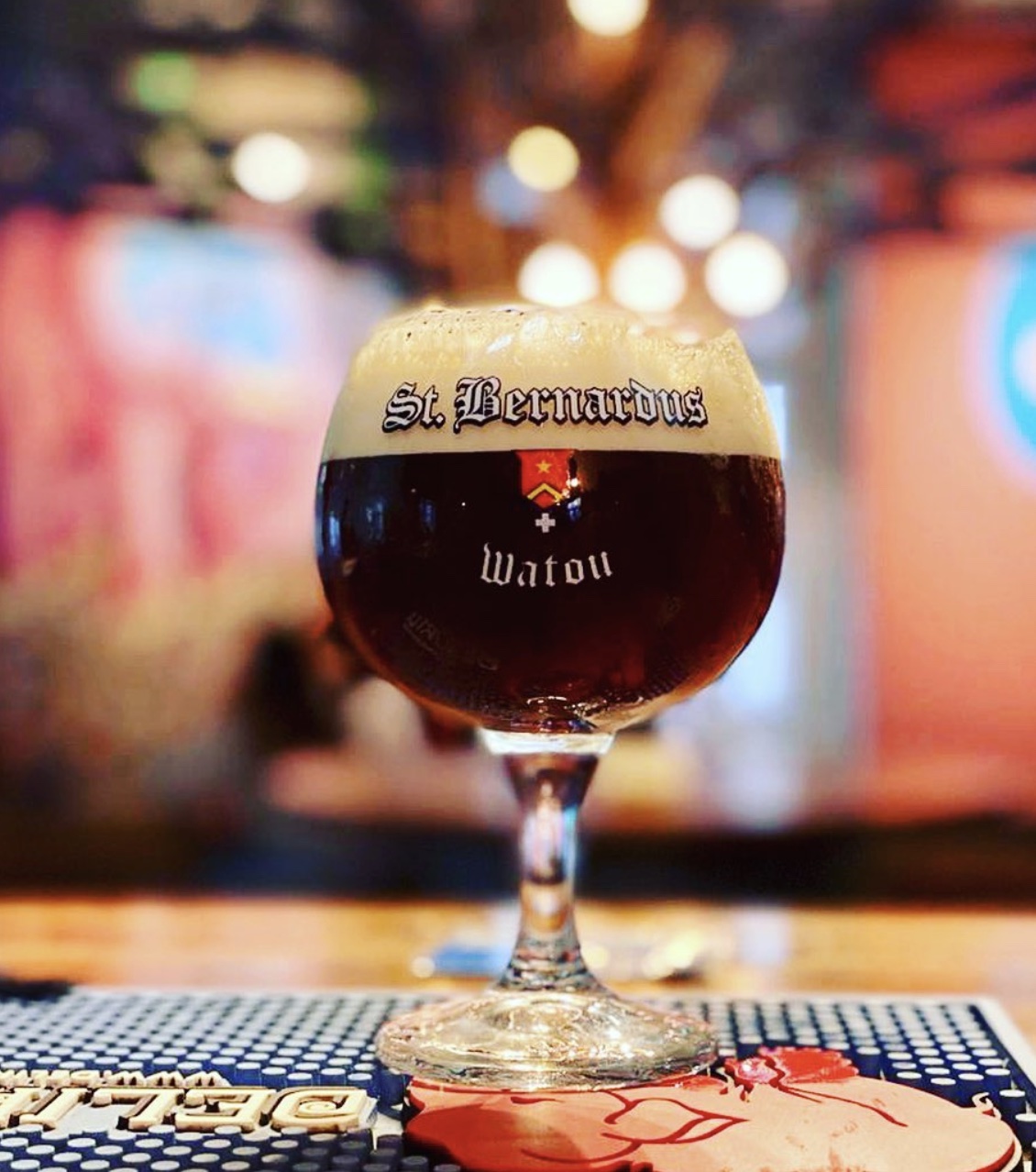
© Delirium Café
Where to drink gluten free beer in Lisbon
In most supermarkets you will be able to purchase gluten free Super Bock, one of Portugal’s most famous beer brands along Sagres. If you prefer going out to drink in Lisbon, we recommend visiting Delirium Café (Calçada Nova de São Francisco 2A), which will have some beer options suitable for celiacs.
When everything else fails… there’s always fast food!
For those looking for a quick and familiar option, McDonald’s in Portugal offers a certified gluten-free menu. This includes gluten free burgers (being that they have buns without gluten, as the patties themselves would naturally be void of gluten), ensuring a fast-food experience that is safe for gluten-sensitive individuals. If you prefer fast-food pizza, be happy to know that Telepizza also has at least two varieties of gluten free pizza.
Portuguese words celiacs and gluten free travelers should know
While eating out as a celiac in Portugal, knowing how to express sem glúten (gluten-free) is essential, as it is widely recognized, at least in urban eateries.
But if you wish to navigate our city’s dining scene a little deeper, here are some valuable words and expressions which will help communicate your dietary needs in Portuguese, so that you can truly enjoy Lisbon gluten free:

‘Eu sou celíaco(a).‘ / ‘I am celiac.’
‘Estou a seguir uma dieta sem glúten.‘ / ‘I am following a gluten-free diet.’
‘Este prato contém glúten?‘ / ‘Does this dish contain gluten?’
‘Há opções sem glúten no menu?’ / ‘Are there gluten-free options on the menu?’
‘Pode verificar se isto contém trigo, cevada, centeio ou aveia?‘ / ‘Can you check if this contains wheat, barley, rye, or oats?’
‘Por favor, use utensílios separados para evitar contaminação cruzada.‘ / ‘Please use separate utensils to avoid cross-contamination.’
‘Posso ver a lista de ingredientes?‘ / ‘Can I see the ingredient list?’
‘A cozinha pode adaptar este prato para ser sem glúten?‘ / ‘Can the kitchen adapt this dish to be gluten-free?’
“Como sou celíaco preciso de saber se o óleo foi também usado para fritar outras coisas, tais como croquetes ou qualquer outra comida com farinha ou pão ralado?” / “As I am celiac, I need to know if the oil was also used to fry other things, such as croquettes or any other food with flour or breadcrumbs?”
‘Obrigado(a) pela sua ajuda!‘ / ‘Thank you for your help!’
We’d recommend having these handy sentences we copied, together with the ones shared along this article, into the notes of your mobile device, so that you can more at ease enjoy your dining out experiences in Lisbon and anywhere else in Portugal.
After reading this guide, we hope you feel confident to not only travel around Lisbon, but to immerse yourself in the most authentic of Portuguese flavors, while still keeping it gluten free. For further tips, refer to the map of gluten free Portugal, and feel free to reach out to us to enjoy the best of gluten free Lisbon and do a food and cultural tour with us!

Guests during our gluten-free 17 Tastings Lisbon food tour
Article by :
Zara Quiroga (freelance food writer and food & cultural leader at Oh! My Cod Pico Trips)
Sílvia Olivença (anthropologist and food guide/CEO at Oh! My Cod Ethnographic Food Tours & Trips)
Photos by:
Sílvia Olivença (anthropologist and food guide/CEO at Oh! My Cod Ethnographic Food Tours & Trips)
Want to more about Portuguese cuisine and its influences?
Fish (r)Evolution: from the Roman times to contemporary Portuguese Chefs
How Portugal influenced Indian cuisine
Alentejo and Algarve: culinary traditions of the South of Portugal

